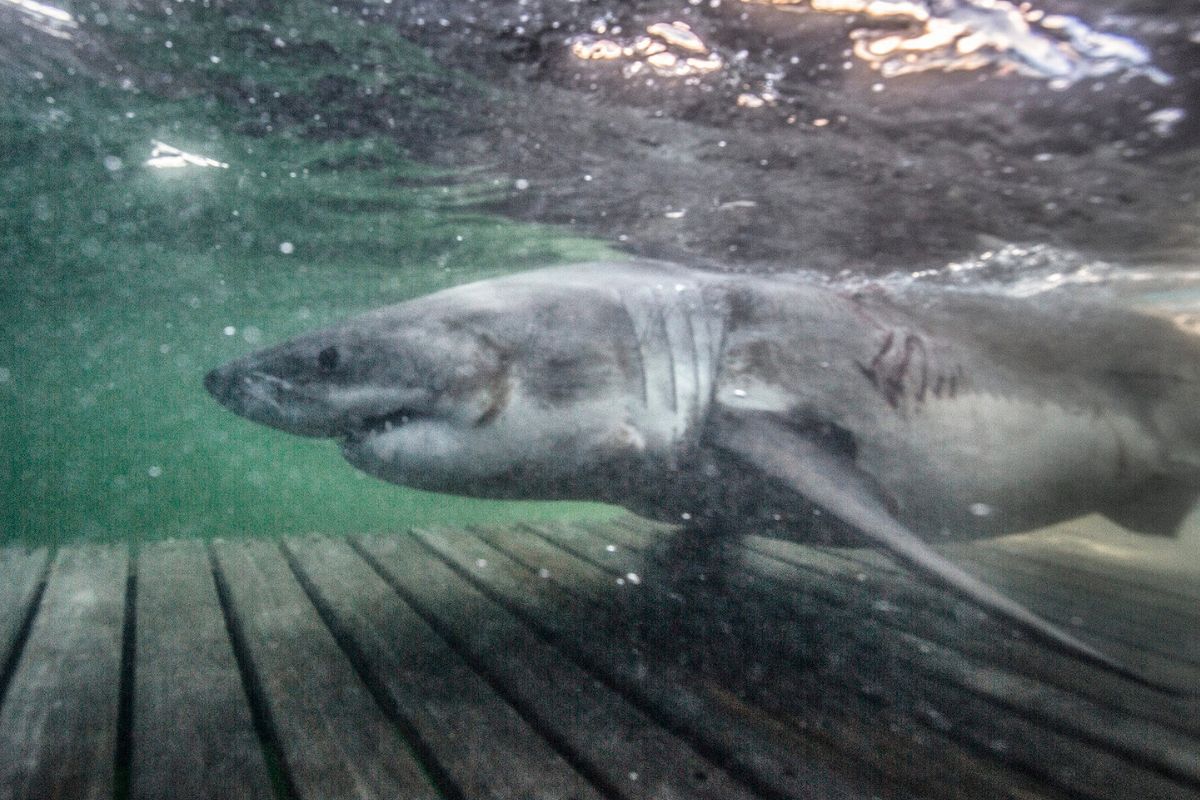In a groundbreaking marine research event, scientists have successfully tagged what is now considered the largest great white shark ever recorded in the Atlantic Ocean. This magnificent predator, nicknamed “Contender,” was encountered off Florida’s eastern coastline in mid-January 2025, marking a significant milestone in shark research and conservation efforts.
Massive predator breaks records in Atlantic waters
On January 17, 2025, marine research organization OCEARCH achieved what many scientists considered nearly impossible – they successfully tagged an enormous male great white shark swimming approximately 45 miles off Florida’s coast. This remarkable specimen, weighing a staggering 1,653 pounds and measuring 13 feet 9 inches in length, immediately claimed the title of largest great white shark ever documented by OCEARCH in Atlantic waters.
The team aptly nicknamed this ocean giant “Contender,” honoring their non-profit partner Contender Boats. Dr. Harley Newton, OCEARCH’s chief veterinarian and senior veterinary scientist, expressed the significance of this discovery in an interview with Oceanographic: “Although we have tagged numerous sharks throughout this project, adult-sized specimens have remained particularly elusive.”
According to Dr. Newton, male white sharks typically reach maturity around 11.5 feet in length and 26 years of age. At nearly 14 feet, Contender is estimated to be an adult male in his early thirties, representing a crucial component of the breeding population. Scientists believe he will play a vital role in rebuilding the western North Atlantic white shark population.
The discovery of such massive marine predators highlights the incredible biodiversity beneath our oceans. Recent NASA scientists mapping the ocean floor identified nearly 100,000 underwater mountains, demonstrating how much remains to be discovered in our vast oceanic ecosystems.
Advanced tracking technology reveals shark movements
OCEARCH employs sophisticated methods to study these magnificent creatures. Their tagging process begins with carefully monitored baited breakaway drumlines. When a shark like Contender takes the bait, researchers retrieve the line attached to a buoy and bring the animal alongside their vessel.
Once secured, the team conducts a comprehensive assessment, including:
- Physical measurements and ultrasound examination
- Collection of biological samples for health evaluation
- Reproductive system analysis
- Diet and nutrition studies
- Toxicology and genetic testing
- Attachment of satellite tracking devices
Two types of satellite tags are attached to monitor Contender’s movements. The fin-mounted SPOT (Smart Position and Temperature) tag provides GPS location data when the shark surfaces, potentially functioning for up to five years. Additionally, a PSAT (Pop-up Satellite Archival Tag) temporarily attached to the shark’s body wall will detach after six months, revealing critical information about underwater behaviors, depth preferences, and temperature tolerances.
This technological approach mirrors other advanced scientific monitoring systems like the ESA’s space watch on the ISS, which represents the most precise timekeeping device ever deployed in space. Both demonstrate humanity’s growing capacity to track and measure our world with unprecedented accuracy.
Since being tagged, Contender has traveled 292 miles further out to sea and southward toward northern Florida. OCEARCH’s online tracking platform provides real-time updates whenever the shark’s dorsal fin breaches long enough for satellites to record its location. The shark was last detected swimming near St. Augustine the previous Friday.
Scientific significance of the record-breaking discovery
The tagging of Contender represents far more than just an impressive statistic. This massive shark joins 94 other tagged specimens in OCEARCH’s western North Atlantic white shark project, collectively enhancing scientific understanding of migration patterns and habitat utilization in this region.
Dr. Newton emphasized that data collected from Contender will significantly contribute to conservation and policy efforts for white sharks and other North Atlantic shark species. The comprehensive nature of this research reflects similar dedication seen in other marine scientific breakthroughs, such as when the French military made a record-breaking discovery 8,421 feet deep that revolutionized underwater archaeology.
Contender’s presence in Atlantic waters also highlights the resilience of marine species. Like the prehistoric wide-snouted creature making a remarkable comeback from endangered status, great white sharks demonstrate nature’s capacity for adaptation and survival despite environmental challenges.
Broader implications for marine conservation
The discovery and tracking of the Atlantic’s largest recorded great white shark carries profound implications for marine conservation. By monitoring Contender’s movements through the mysterious marine ecosystem, scientists gain valuable insights into predator behavior and ecological relationships.
OCEARCH has democratized this scientific research by making tracking data publicly accessible through their free desktop tracker and smartphone applications. This transparency allows anyone to follow Contender’s journey in near real-time, fostering greater public engagement with marine conservation efforts.
The magnitude of this discovery echoes other natural phenomena that have shaped our understanding of Earth’s systems, such as the 1960 Valdivia earthquake in Chile, the most powerful ever recorded. Both events remind us of nature’s awesome scale and our need to study these phenomena systematically.
As research continues, scientists anticipate that data from Contender and other tagged sharks will reveal new insights about these magnificent ocean predators. Like astronomers observing rare red sprites in the skies or scientists planning the Tianwen-2 asteroid sample mission, marine biologists studying these apex predators continue expanding the frontiers of human knowledge about our natural world.
